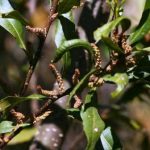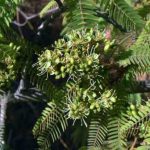TREE LIFE
November 1982
MASHONALAND CALENDAR
Tuesday November 2nd : Botanic Garden Walk. Meet in the Car Park at 1645 for 1700 hours.
Sunday November 21st : A day with a difference. Fare $5.00. We shall leave the Monomatapa Car Park at 0830 hours and travel out on the enterprise Road stopping at Chisipite to pick up any members who would prefer to join the bus there and at the 12km peg just after the Orange Kiosk take the left hand fork and travel along the Shamva road until shortly after the 24km peg when we shall turn left at the road which has a sign board “Springs Farm- H. H. Turner”. (anyone coming independently please follow the Society signs from that point). We shall spend about an hour looking at Ian Turner’s garden which is full of aloes, cycads and shade plants and which incidentally contains an Ekebergia capensis and a Diospyros whyteana both first species and I am assured that they have not been planted. About 10 to 1030 we shall return to the Shamva road and travel another 2km and just before the 26km peg turn right over a white painted culvert and go up to the base of the hill for a look at the trees there and to have lunch. After lunch we shall again board the bus and head for Ewanrigg Aloe Gardens; turn off to which is a further 10km along the Shamva road on to Christian Road on the right hand side. We should arrive by 1430 hours when Mr. Smith-Wright will introduce us to his recently laid out Herb Garden. We can then either wander through the gardens or have another look at trees depending on one’s inclination and energy.
Saturday 4th December : National Tree Planting Day.
Sunday December 19th : Craig Hill. 1000 hours onwards. Paul and I should be delighted if you would join us for morning tea, and if you are to bring lunch and make a day of it so much the better. Since last year many more trees have been planted and we have discovered Annona senegalensis, Wild Custard Apple growing naturally.
LEARNER GROUP : A meeting of this group will be held on Saturday 30th October at 0915 hours. Please will anyone who would like to join us phone Mrs. Gill Masterson. We like to limit the numbers in order for those who do attend to receive individual attention. On this occasion we have a definite limit but there will be a next time, soon, which you can discuss with Gill.
BOTANIC GARDEN WALK
We again looked at Acacias, this time Acacias with prickles and using what Tom told us and a key which he has compiled, it is my intention to produce a rule of thumb or rough guide to that group of Acacias. Unfortunately it has not been possible to complete it in time for this newsletter.
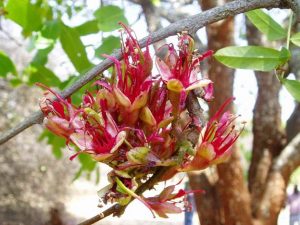
Schotia brachypetala flowering. Photo: Mark Hyde. Source: Flora of Zimbabwe
Despite having a destination the members of this Society are quite incapable of walking past and ignoring an interesting or eye catching tree. The Schotia brachypetala, an anthill inhabitant, was still in flower, and the patch of Acacia xanthophloea, fever trees, was very striking with their yellow flowers and yellow bark. We looked closely at the bark and some areas appeared as though they were rough and diseased but these rough areas fall off leaving a lovely mottling underneath. Acacia xanthophloea used to be blamed for transmitting malaria simply because they grow in low lying swampy areas where one would find malaria anyway. There are a number of other trees called Fever Trees for the same reason, but this is THE fever tree which Rudyard Kipling referred to as growing on “the banks of the great grey-green greasy Limpopo River.” That group in the Botanic Garden have been there for about 11 years and must be a source of satisfaction and pleasure to Tom as they have done so well. Gardenia resiniflua, gummy Gardenia also caught our attention firstly because it has a puckered leaf which is very different from the species we usually see and secondly because it was exuding a drop of gum at the tip of the growing shoots. The specific name refers to this characteristic but I have not seen it before. This is a species of low altitudes.
And then we reached the Acacias about which I hope to include in a future Newsletter.
VISIT TO KIMCOTE FARM, SUNDAY 17TH OCTOBER 1982
After the rush and bustle and excitement of the trip to Kwekwe our visit to Kimcote was one of quiet relaxation. The day was fairly overcast and there was a pleasant breeze, in fact when we arrived one member complained about the cold, and while that condition did not persist at no time did we find it unbearably hot. Remarkable for October.
This is an area of typical Brachystegia woodland with the dominant species being Msasa, Brachystegia spiciformis and Mnondo, Julbernardia globiflora and a few Mfuti or Prince of Wales Feathers, Brachystegia boehmii, all towering well above our heads and identified in the main by the pods on the ground. First we wandered over rocky outcrops where the Common Tarenna, Tarenna neurophylla with its shiny green drooping leaves was conspicuous and bigger than we often see it. In fact I had to borrow a stick to reach some branches in order to try and demonstrate the interpetiolar stipule, the trade mark of the family RUBIACEAE to which this belongs. Unfortunately the leaves were last season’s growth so we had to examine many before we found what we were looking for. Also a RUBIATE but with the interpetiolar stipule almost impossible to see was Gardenia volkensii (G. spatulifolia) with fresh white flowers, fading yellow flowers and fruit from the previous year. This had a crusty coat and then a fibrous layer inside which the fleshy part used to be, now only containing stuck together seeds rather like small dark capsicum or green pepper seed arranged like those of a melon.
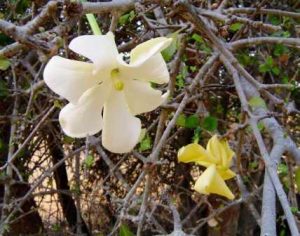
Gardenia volkensii flowers. Photo: Bart Wursten. Source: Flora of Zimbabwe
As to be expected at this time of the year many of the trees were in flower, none as spectacular as the Gardenia but all fascinating and interesting in their own way. There were the tiny yellow flowers of the Mukwa, Pterocarpus angolensis lying on the ground, having fallen from branches so far above us that there was discussion as to which tree they had come from and which were more sweetly fragrant that those of the gardenia. Both species of Ximenia, the sour plum, were in flower. The flowers almost identical, small, white inconspicuous, those of X. caffra, large sour plum, are borne singly on peduncles – flower stalks – while those of X. americana, small sour plum, frequently have a branched peduncle bearing more than one flower. This is the only definite feature which separates the two species, although X. americana with its shrub like habit and blue green glabrous leaves was quite distinguishable from the rust-haired leaves of X. caffra, which were growing as small trees. Also with blue green leaves but with tiny yellow flowers and green fruit was Osyris lanceolata. And another species with inconspicuous flowers but in places flowering so heavily as to be spectacular, was Diospyros lycioides, red star apple; mostly growing as small to large shrubs although there was one which had reached a very admirable tree shape with a 30cm diameter trunk and a very dark smooth bark. It looked as though it really had a hard wood, although knowing that it is a member of the family EBENACEAE may have mentally added to this impression.
Without any leaves to tell us which was the hairier we saw first Vangueria infausta, wild medlar, and then Vangueriopsis lanciflora, false wild medlar, in flower, and their flowers are indeed very different. Those of V. infausta are cream, bell shaped and only about 6mm in diameter, while those of Vangueriopsis, also small and cream coloured, have long petals which curve right back reminiscent of a lyre. These flowers open out of long narrow or lance shaped buds which gives this its specific name.
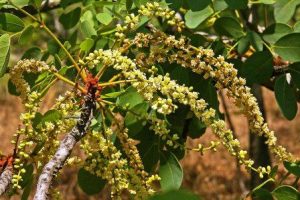
Burkea africana flowers. Photo: Meg Coates Palgrave. Source: Flora of Zimbabwe
Burkea africana was mostly in bud but did have a few open flowers on their long strings. This was one of the species with compound, twice divided or bi-pinnate leaves which we looked at. Of course the distinguishing feature of Burkea is the presence of the brown velvet growing tips to the branches. We meant to look to see if it has a gland on the petiole which would have added to the similarities between this and Albizia antunesiana, purple leaved Albizia, which definitely has one, but no velvet tips. Its distinctive feature is the pale under surface of the leaflets and the purple hue which is often present. Also bi-pinnate but with feathery leaflets was Albizia amara, bitter Albizia which does have a gland on the petiole but for which again we did not look, however, we were sure that it could not be Peltophorum africanum because that we had seen earlier with its fern like stipules. Both those species are unarmed, i.e. without thorns, which distinguishes them from Dichrostachys cinerea, Chinese Lantern or Sickle pod, with its modified branchlets ending in a shape point and Acacia sieberiana, paperback Acacia, with its paired spines and under whose umbrellas we sat for lunch.
And this is a good point at which to discuss thorns, spines and prickles. The ordinary dictionaries refer to thorns as prickles and to prickles as thorns and to spines as both. However, in the Glossaries of Botanical Terms in the various books to which I have referred there is no mention of thorns. There are either prickles which are sharp outgrowths of the bark or surface layer, like those of a rose, or spines which are sharp pointed hardened structures modified from another organ e.g. branchlets as in the case of Dichrostachys, or stipules, as in the case of the straight spined Acacias, or leaves, or from part of another organ. And, botanically speaking, a spike has nothing to do with the subject as that refers to an inflorescence or cluster of flowers, usually without stalks, arranged along a central stem.
After lunch we wandered in the opposite direction to that of the morning. This is an area apparently of sandveld but which can become very wet and vlei like. One of the features of this walk was the number of dwarf species of the same genera and close relations to tree species we know so well.
First there was Lannea edulis, Dwarf Lannea, which in Flora Zambeziaca Vol. 2 part 2 ANACARDIACEAE is described by R. and A. Fernandes as a “Suffrutex with stems 3-30cm high, at first ferniginous-stellate tomentose later glabrescent arising from a large nodose rugose woody trailing rootstock”. Is not that a lovely description? Translated it means a shrublet which is perennial and usually produces leaf and flowering shoots each year, these are about 3 – 30 cm high and have rust coloured star like hairs at first which fall off later on. The stems are produced from the nodes (the place where stems and leaves normally arise) of a wrinkled creeping root-like stem which apparently can cover an area several meters square. Usually the fruit appears before the leaves which are remarkably like the leaves of our familiar Lannea discolor, live-long, as are the fruit which ripen to dark red or almost maroon and are edible. It is a fairly common species. There was great excitement when we found the Dwarf Ochna, Ochna macrocalyx in flower. This probably has one of the largest Ochna flowers and it was right at ground level. This is another species with a large underground root and which flowers before the leaves appear. We saw them in leaf at Sable Park, Kwekwe and at Stanley Farm, Chegutu, where we wondered if those were in fact a bonsai form of Ochna schweinfurthiana, but having consulted the literature I see that they can grow up to 2m and have leaves with a densely toothed margin so we were probably wrong. Ochna macrocalyx is described as widespread but not common. Our next shrublet with flowers and leaves was Parinari capensis, sand apple, which could just as well be called the Dwarf Parinari curatellifolia. In fact there has been speculation as to whether it is not merely the same species dwarfed as a result of being burnt annually. However, the leaf shape is different; those of P. capensis being comparatively narrower and tapering at both ends while those of the true P. curatellifolia are more oblong with an almost rounded apex and base and on that feature they have been maintained as a separate species. This was in flower adding to its claim. It characteristically occurs in sandveld forming a ground cover up to about 30cm high growing from an extensive underground root like stem. There has also been speculation as to whether the Dwarf Waterberry
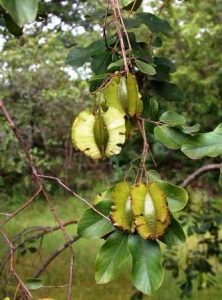
Combretum zeyheri, large-fruited Combretum. Photo: Rob Burrett. Source: Flora of Zimbabwe
Syzygium huillensis, another sub-shrub, this time evergreen, is a separate species or a frosted every year form or subspecies of Syzygium quineense, woodland waterberry. We saw patches of it, about 30 to 35cm high, many stemmed, obviously growing from its woody rootstock. There were lots of buds but no flowers or fruit which is typical edible waterberry. In small red flower was Combretum platypetalum, Dwarf red Combretum, another sub-shrub with shoots arising from an underground rootstock each year. It has characteristic 4 winged Combretum pods which are red and form one of the first splashes of colour of the season, albeit at ground level, especially noticeable after a fire or along road verges. “platypetalum” means broad petals which is rather a strange name for something with petals about 2.5cm wide but glancing through COMBRETACEAE none of them seem to have petals any broader.
With the largest pods in the Combretum genus was Combretum zeyheri, large-fruited Combretum, the trees still festooned although there were many fruit on the ground. And completely free of adornment were the beautiful pealing barks of the many Peeling-bark Ochna, Ochna pulchra, to fill our cups to overflowing.
In the end no one wanted to leave the giants or the dwarfs and all had to be chivied to board the bus and head for home. Kimcote always has been and still is a special place.
AYSHIRE BRANCH
The 9th AGM will be held at 1700 hours on Thursday 11th November at Wye Farm. Directions : From Raffingora travel 14km along the Sipolilo road. Turn left on crest of hill at plough disc sign post – D.D.Henderson, Wye.
AGENDA
- Apologies
- Minutes of 8th AGM held on 19th November 1981
- Matters arising
- Chairman’s Report
- Finance
- Election of officers
- Proposals for 1983
- Any other business
If any member wishes an item/resolution to be included on the Agenda, would they please advise the Secretary, Mrs. B. Graves before 20th October 1982.
Derek and Gill Henderson cordially invite you and your family to join them after the AGM for a braai. RSVP Gill Henderson.
On Thursday 7th October a field afternoon was held at Katawa Farm. This was attended by 12 members of the Commercial Farming Community and 73 people representing their employees.
Mr. James Gandari, Assistant PRO, Department of Natural Resources started the proceedings by showing two films, the first in English, an appeal to save Mana Pools from being flooded by the proposed Mpata Gorge Scheme and the second in shone titled “Trees Alive”.
We then moved outside to a road verge where Mr George Hall, demonstrated reclaiming stumps to encourage “Woodland Regrowth” the theme for the event. This included scuffling around the regenerating saplings with a badza and finally placing bricks around them for protection and to signify that they were being protected.
Mr. Gandari then spoke most persuasively in Shona, encouraging discussion and answering questions. The afternoon ended with tea and cool drinks for everyone.
Thanks indeed to Mr. Gandari and Mr. Hall for a most stimulating afternoon.
And as a foot note. One of the farmers whose staff attended has noticed little circles of his best bricks throughout his compound. The message will be diplomatically spread that half bricks and stones are just as effective!!
MATABELELAND BRANCH
Sunday November 7th : Meet at 0830 hours at the junction of Fortune’s Gate Road and Essexvale Road. It is proposed to go to that interesting area of Bulawayo Drive, Burnside, which has the varied vegetation associated with granite. We have been asked to tag the trees on a large lot which is to be given to KGVI School.
Sunday December 5th : Notice is hereby given that the AGM of the Matabeleland Branch will be held at 6 Caithness Road, Hillside at 1000 hours. Please make every effort to attend.
Miss Janet Webber will be leaving Bulawayo to join her sister in East London and work at the Museum there and the November meeting will be her last before her departure. She has been Secretary of the Matabeleland Branch for the last 6 or 7 years which follows a couple of years as Chairman and I am sure I speak for everyone when I say how much we shall miss Janet and her interest, knowledge and enthusiasm.
We wish Janet every happiness for the future. Recently she sent this snippet :
“A friend recently wrote from Edinburgh as follows : There has been a lot of controversy about the Pope’s visit to Britain in May. In Glasgow they have taken up a lot of full grown trees at a big park where the Pope is going to preach so that people can see the Pope. They will plant the trees elsewhere for the time being and then put them back where they came from. You can imagine the outcry. The operations is costing thousands of pounds.”
And from Triangle comes a letter from Mr. Chris Lightfoot who comments on the article on Regrowth Protection by George Hall :
- The basal area of tree growth an area can support is controlled by limiting factors, usually moisture – lots of small trees, or a few big ones. So manage accordingly (no.of stems)
- When cutting for regrowth, cut clearly, with axe, rather than chainsaws, and avoid damage to the cambial layer from which regrowth arises.
- I wonder about George’s assertion on height. I believe the practice of cutting high was to depress regrowth. Certainly our experience here with mopane and gums, is to cut at about 25cm – 50cm for best regrowth. On the other hand, the trunk does store foods for regrowth, so too low will also debilitate the stock. The timing in relation to translocation is also important. When the sap is down, you can do what you please.
- Fire often enhances the ratio of stems to area – by reducing the number, if the timing is again right, both with respect to average height and sap/season. For firewood, many, small stems is more acceptable, so a high density of stems is what is required. Also gives good average annual production of biomass. However, Eucalypts still offer the best production per unit area per annum and therefore take up far less land than indigenous woodland regrowth per unit of biomass produced, especially in better rainfall areas.”
-Meg Coates Palgrave Chairperson


